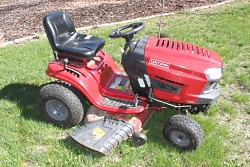
Courtesy & Copyright Ron Hellstern, Photographer
Did you know
-
- Approximately 20 million U.S. acres are now planted as residential lawn.
-
- 30-60% of urban freshwater is used for watering lawns.
-
- 67 million pounds of synthetic pesticides are used on U.S. lawns annually.
-
- Areas of lawn that include only one type of plant, such as grass, offer very little habitat value for wildlife.
-
- Yard waste, mostly grass clippings, makes up 20% of municipal solid waste collected, and most of it ends up in landfills.
- Reasons to reduce your lawn
-
- Save time and money that you would normally spend on mowing and fertilizing grass.
-
- Provide habitat and food for wildlife.
-
- Conserve water.
-
- Reduce lawn mower pollution and decrease run-off from fertilizers and pesticides.
- Here are some ways to reduce your lawn and help wildlife
-
- Use native plant species as ground cover instead of grass.
-
- Install native trees and shrubs
-
- Create a rock garden
-
- Use mulched pathways
-
- Provide meadow or prairie patches
-
- Install a hedgerow
-
- Plant an organic vegetable garden
-
- Create a butterfly or hummingbird garden
- Taking Action
- Make a plan of how you want your yard to look. Check with your local municipality, neighborhood, or homeowners’ association for regulations. Once you have decided on an area of your yard to convert, follow these simple suggestions:
-
- Cover your turf grass with 6-10 layers of black & white newspaper or brown cardboard. There is no need to remove the grass first.
-
- Make sure the sections overlap one another so that grass and weeds will not come up between the cracks.
-
- Wet down the newspaper or cardboard.
-
- Cover the newspaper or cardboard with a 4”- 6” layer of mulch or soil.
-
- Allow turf grass and weeds to die back for 4-6 weeks.
-
- Plant directly through the mulch and newspaper/cardboard. If you know you’re going to be planting trees or shrubs, dig the holes before putting down layers of paper.
- Some other things to consider
-
- Determine what native plants are already thriving in your site. Encourage the native plants already present and replace exotic invasive species with native ones. The Lady Bird Johnson Wildflower Center has lists of recommended native plants by region and state at www.wildflower.org/collections. There are 158 listed for Utah.
- Organic mulch can reduce weeds, prevent erosion, improve soil nutrients and increase water holding capacity.
- Borders of rock or weed can bring a sense of order to a “wild garden” in an urban or suburban neighborhood. This may make your natural landscape more acceptable to neighbors.
- And don’t forget to make a place for people as well. A bench or path will accommodate this nicely and add to your enjoyment.
- Determine what native plants are already thriving in your site. Encourage the native plants already present and replace exotic invasive species with native ones. The Lady Bird Johnson Wildflower Center has lists of recommended native plants by region and state at www.wildflower.org/collections. There are 158 listed for Utah.
This is Ron Hellstern, and I am Wild About Utah.
Credits:
Images: Courtesy & Copyright
Audio: Courtesy & Copyright Kevin Colver
Text: Ron Hellstern, Cache Valley Wildlife Association
Additional Reading
Lawn Reduction, The National Wildlife Federation, https://www.nwf.org/-/media/PDFs/Garden-for-Wildlife/Gardening-Tips/Lawn-Reduction_web.ashx?la=en&hash=FAC102D0BDBBC0CCD97ECE01BB9A8E2F91E7C150
Hadden, Evelyn J, Less Lawn, more life, LessLawn.com, https://www.lesslawn.com/
Plant Lists & Collections, Recommended Species by State, Lady Bird Johnson Wildflower Center, www.wildflower.org/collections
